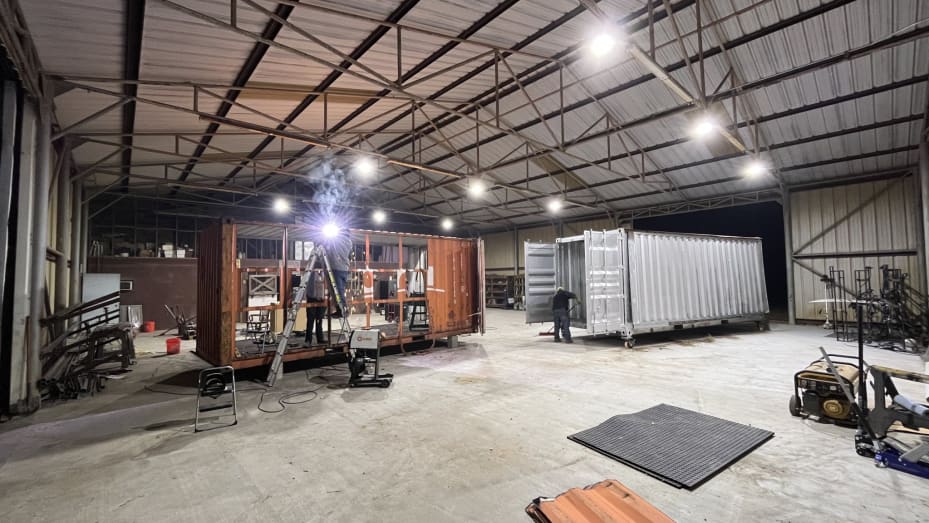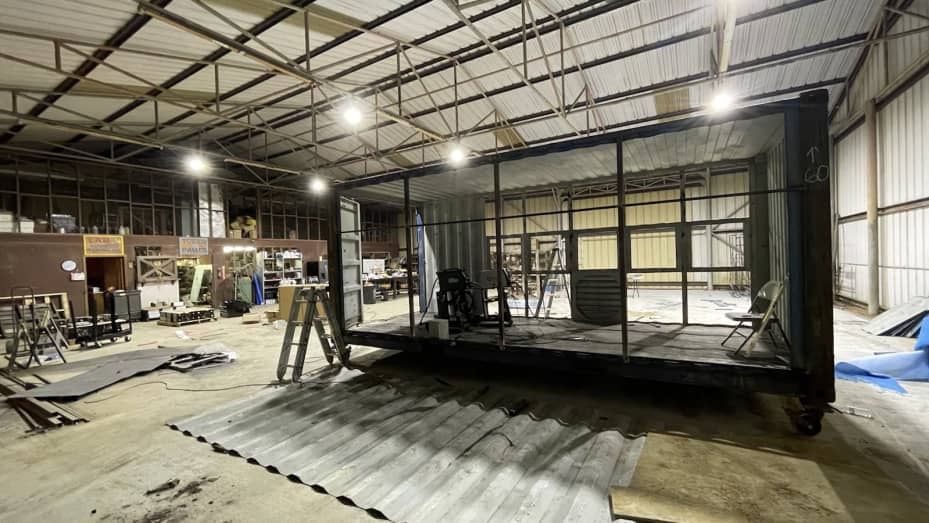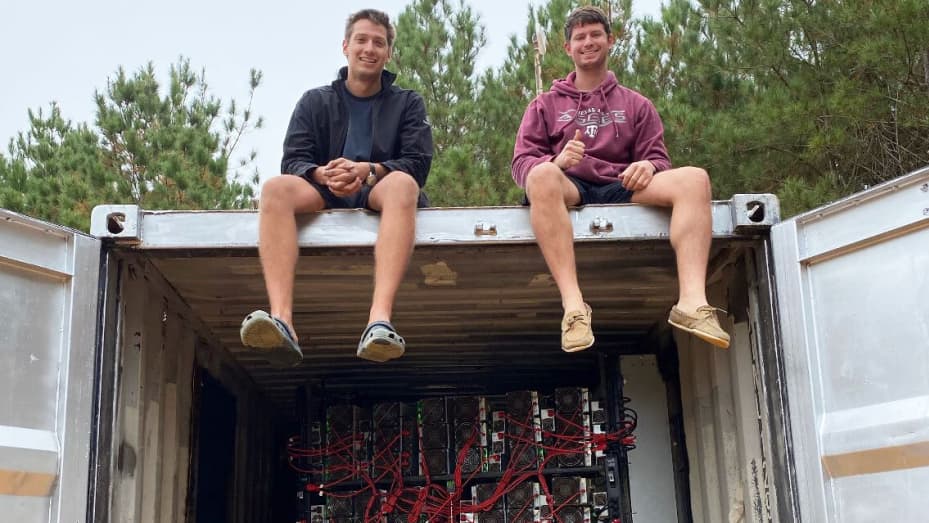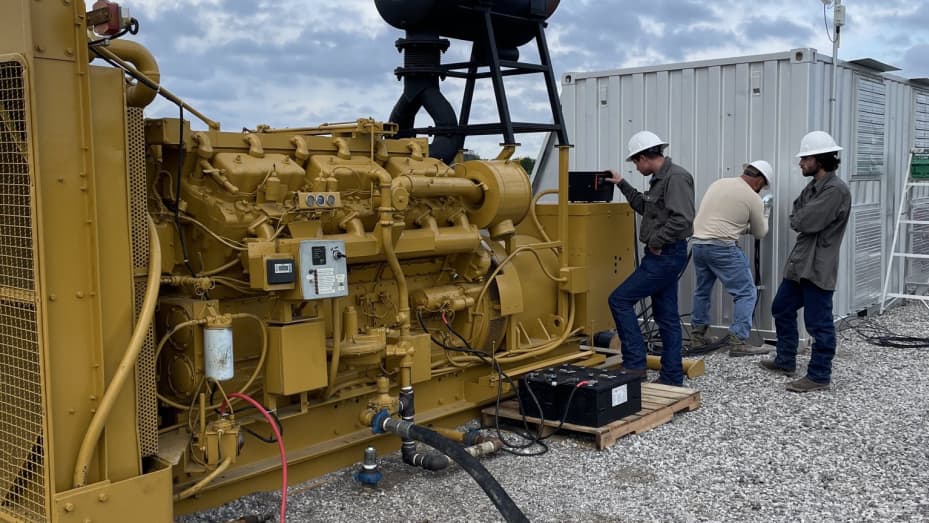When Brent Whitehead and Matt Lohstroh were sophomores at Texas A&M University, they decided to get into the business of mining bitcoin on the oil fields of East Texas.
The year was 2019, and at the time, the idea of oil and gas companies joining forces with bitcoin miners was considered both avant-garde — and a major taboo.
But Whitehead, an engineer hailing from a family with a long history in oil and gas production, and Lohstroh, a finance major with a bitcoin obsession, ignored the skeptics, and sunk all the cash they had earned from their high school side gigs in lawn care and landscaping into Giga Energy Solutions, a company that mints bitcoin from stranded natural gas.
For years, oil and gas companies have struggled with the problem of what to do when they accidentally hit a natural gas formation while drilling for oil. Whereas oil can easily be trucked out to a remote destination, gas delivery requires a pipeline.
If a drilling site is right next door to a pipeline, they chuck the gas in and take whatever cash the buyer on the other end is willing to pay that day. But if it’s 20 miles from a pipeline, drillers often burn it off, or flare it. That is why you will typically see flames rising from oil fields.
Beyond the environmental implications of flare gas, drillers are also, in effect, burning cash. To these two 23-year-old Aggie alums, it was a big problem with an obvious solution.
Giga places a shipping container full of thousands of bitcoin miners on an oil well, then diverts the natural gas into generators, which convert the gas into electricity that is then used to power the miners. The process reduces CO2-equivalent emissions by about 63% compared to continued flaring, according to research from Denver-based Crusoe Energy Systems.
“Growing up, I always saw flares, just being in the oil and gas industry. I knew how wasteful it was,” Whitehead told CNBC on the sidelines of the North American Prospect Expo summit in Houston, a flagship event for the industry. “It’s a new way to not only lower emissions but to monetize gas.”

Whitehead tells CNBC they have signed deals with more than 20 oil and gas companies, four of which are publicly traded. Giga also says they’re also in talks with sovereign wealth funds, and they are expanding, fast. Giga’s 11-person team is adding another six employees this month.
Lohstroh and Whitehead are part of a growing movement of people placing big bets on the potential for bitcoin mining to transform the economics of the energy industry.
“They are making their clients revenue through stranded energy bitcoin mining and solving the environmental challenge with flared gas at the same time,” said Lee Bratcher, president of the Texas Blockchain Council.

Giga’s shop in Beaumont, TexasMatt Lohstroh
The Giga executives are also big believers in the power of bitcoin to create a new kind of financial freedom.
“No one controls it, and you don’t have to ask permission to use it,” said Lohstroh. “That’s really what drew me to bitcoin.”
It’s a similar sentiment for Whitehead, who tells CNBC that his views on self sovereignty, privacy, and individualism are part of what sent him down the proverbial bitcoin rabbit hole.
“I wasn’t so much focused on the price, as I was the adoption. I thought this was something great for humanity,” said Whitehead.
Oil and gas meets bitcoin
You can think of bitcoin mining both as the security layer for the network and as the method by which new bitcoin are entered into circulation.
A bitcoin mining rig runs a program on a computer to try to solve a puzzle before anyone else does. Solving that puzzle is what completes a block, a process that both creates new bitcoin and updates the digital ledger keeping track of all bitcoin transactions.
“The cool thing about bitcoin that is under-appreciated by a lot of the naysayers is that it’s a portable market; you can bring it right to the source of energy,” said Steve Barbour, founder of Upstream Data, a Canadian company that manufactures and supplies portable mining solutions for oil and gas facilities.
Enter the oil and gas business, which often features sites in remote parts of Texas, far from major population centers.
More often than not, if a gas well isn’t already stationed near a pipeline, it won’t be big enough to warrant the time and expense of building an entirely new line. And if a driller can’t immediately find a way to sell the stash of natural gas, most dispose of it on site.
One method is to vent it, which releases methane directly into the air – a poor choice for the environment, as its greenhouse effects are shown to be much stronger than carbon dioxide. A more environmentally friendly option is to flare it, which means actually lighting the gas on fire.
But flares are only 75 to 90% efficient, explained Adam Ortolf, who heads up business development in the U.S. for Upstream Data. “Even with a flare, some of the methane is being vented without being combusted,” he said.
This is when on-site bitcoin mining can prove to be especially impactful.
When the methane is run into an engine or generator, 100% of the methane is combusted and none of it leaks or vents into the air, according to Ortolf.

“But nobody will run it through a generator unless they can make money, because generators cost money to acquire and maintain,” he said. “So unless it’s economically sustainable, producers won’t internally combust the gas.”
Bitcoin makes it economically sustainable for oil and gas companies to combust their methane, rather than externally combust it with a flare, rendering stranded gas a thing of the past.
But Ortolf has taken years to convince people that parking a trailer full of ASICs on an oil and gas field is a smart and financially sound idea.
“In 2018, I got laughed out of the room when I talked about mining bitcoin on flared gas,” said Ortolf. “The concept of bringing hydrocarbons to market without a counterparty was laughable.”
Fast forward four years, and business at Upstream is booming. It now works with 140 bitcoin mines across North America.
“This is the best gift the oil and gas industry could’ve gotten,” said Ortolf. “They were leaving a lot of hydrocarbons on the table, but now, they’re no longer limited by geography to sell energy.”
Meanwhile, bitcoin miners get what they want most: cheap electricity.
“The thing about oil and gas is that it is a very distributed and reliable power source, and because of that, a distributed sales point and reliable power draw like a bitcoin mine is quite a good fit,” said Barbour. “It’s sort of a match made in heaven actually.”
Ignoring the haters
The summer before his junior year in college, Whitehead was mowing his parents’ lawn in the southeast Texas town of Buna (population circa 2,000 people) when he got a text from Lohstroh, then a classmate and friend. In it, Lohstroh suggested they buy a mobile bitcoin mining container from Upstream Data and hitch it to a gas well themselves.
“I just instantly stopped the lawn mower, walked straight to my dad, and I was like, ‘I gotta find flare gas right now,’” said Whitehead.
It was a natural reaction for Whitehead, who comes from a long line of “wildcats,” a term used to describe those who engage in high-risk exploratory drilling.
“I call myself a digital wildcatter because now this is this next phase of wildcatting — bitcoin mining going to natural gas wells,” he said.
A week after Whitehead got the text, he and Lohstroh hopped on a plane up to Canada. Logistical acrobatics ensued, including having to drive a U-Haul truck three hours to Upstream’s facility in Calgary since neither was old enough to rent a car, but the pair wasn’t phased.

Upstream’s lead engineer and founder, Steve Barbour, tells CNBC he initially tried to warn Lohstroh not to make a purchase, since the container was still being field tested, but Lohstroh was committed to getting an order in.
“True bitcoiners those two…they’re go-getters,” Barbour said of the Giga co-founders. “Both of them are what I, as a Canadian, think of Texans — entrepreneurial and wholesome. Just awesome dudes.”
Once the college classmates had the physical equipment they needed, they leveraged a connection who had some flare gas.
From there, they pounded the pavement looking to drum up business. At the 2020 NAPE summit, the Giga co-founders say they handed out about a thousand pamphlets trying to sell people on the idea of monetizing stranded gas.
“A lot of people didn’t know about it. Most people laughed at us. Most people said, ‘It’s the stupidest thing I’ve ever heard,’” Whitehead said. Others said it was cool, but they didn’t think it would work, and then, there were a few who said we needed to talk to the company’s CEO.
Then came the pandemic.
“Covid hit and shut down the world,” Whitehead told CNBC. Despite nationwide lockdowns, Giga continued to run 35 miners at its launch site, but business development virtually ground to a halt.
“There was no traction in the space,” said Lohstroh. “Bitcoin was in a bear market. We were running around to meetings trying to draw up interest about bitcoin mining, and there was no interest at all.”

The team got creative by tracking down smaller customers in north and east Texas who were either “breaking the rules” or couldn’t get permits and were just wasting the gas. As Whitehead describes it, these smaller companies were often the ones that neglected regulatory compliance.
“We were able to come in and say, ‘Hey, you’re flaring, and you shouldn’t be. You’re doing stuff that’s illegal, and you have opportunity here, because you have a shut-in well. We can take all this gas,’” recounted Whitehead.
But the real turning point for the company came in Dec. 2020, when the price of bitcoin broached the $20,000 threshold. That’s when some of the bigger players in the oil and gas industry started to take note, and leaders from publicly-traded companies began to approach them about getting into business.
Giga has also had companies fly in from abroad to shadow their operations and learn how the process works.
“We’ve had people from companies in Saudi Arabia come to our sites in East Texas. And you know, they’ve probably never even seen a pine tree before, and we’re bringing them out for barbecue and showing them a bitcoin mine. They love it,” said Whitehead.

Giga tells CNBC that its revenue was more than $4 million in 2021, and it’s on track to earn more than $20 million by the end of 2022.
Whitehead says that some of their mining sites have helped to revitalize the local economy by creating jobs, such as field technicians and bitcoin pumpers, who go out to check the sites. In the small communities where they’ve set up a bitcoin mine, they are sometimes the largest source of revenue.
“An area that was just a ghost town has now found ways to take their stranded energy that they were wasting and monetize it, and that’s what gets me excited, because like that’s what is helping the community overall,” said Whitehead.
Countless bitcoin miners now say that oil and gas is going to dominate the crypto mining industry in the coming decades, which bodes well for Giga’s business model.
“It’s a frenzy out there,” said Barbour.
But Lohstroh tells CNBC the next stage is for the energy producers themselves to become the bitcoin miners.
“I think that’s the next large transition, whether that’d be power producers, natural gas producers, upstream, midstream, downstream. I think at all sectors within the industry space, they’re going to be affected by bitcoin mining, because bitcoin mining is innately tied to power, and the point of energy is to create power. And so I think you’re gonna see a lot of semantics and how they’re interrelated,” he said.
Read full story on CNBC News



